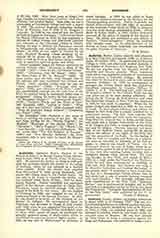

Anderson, HENRY JAMES, scientist and educator, b. in New York City, February 6, 1799; d. at Lahore, India, October 19, 1875. He graduated at Columbia College in 1818, and afterwards studied medicine at the College of Physicians and Surgeons, New York. He did not practice long, but devoted himself to scientific and literary pursuits. When twenty-six years old he was appointed professor of mathematics and astronomy in Columbia College. He retained this chair for twenty-five years, and in 1866 became emeritus professor. In 1848 he accompanied as geologist, the United States Dead Sea exploration expedition commanded by Captain William F. Lynch, U.S.N. The following year, while abroad, he became a convert to the Catholic Faith and was ever after one of its most zealous adherents. He joined the St. Vincent de Paul Society, and when the Particular Council of New York was instituted in 1856 he was made its president. When the Supreme Council was organized in 1860, he was chosen its head. To his example, influence, and labors the Society in New York City is greatly indebted for its subsequent success. The New York Catholic Protectory was founded and built under his inspiration. Pope Pius IX received him in Rome several times, and made him a Knight Commander of the Order of St. Gregory the Great in recognition of his merits and zeal for religion. He was organizer and president of the Catholic Union, having for its special objects the defense of the rights of the Holy See, and the promotion of the Faith. In the Spring of 1875 he went to Lourdes and Rome as a pilgrim, and later on travelled to Australia, at his own expense, to observe the transit of Venus. On his homeward journey, by way of India, where he accomplished an ascent of one of the Himalayan peaks, he was, soon after reaching Lahore, stricken with a malignant disease which proved fatal. His body was brought to New York, and buried March 19, 1876, in a vault under the Church of the Madonna, which he had been instrumental in building, at Fort Lee, New Jersey. His requiem was sung in St. Patrick’s Cathedral, and Cardinal McCloskey, in the sermon, said: “I remember to have heard from the lips of a distinguished Oxford scholar that he had never met a man of greater learning tempered with such humility.” His principal writings were early contributions to the New York “Quarterly Review” and to mathematical journals, and in 1848 and 1849 two geological reports by him on the Dead Sea Expedition, “Geological Reconnaissance of Part of the Holy Land,” were published by the U.S. government.
THOMAS F. MEEHAN

